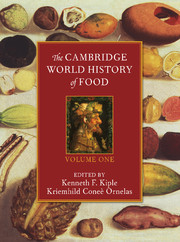Book contents
- Frontmatter
- Introduction
- Part I Determining What Our Ancestors Ate
- Part II Staple Foods: Domesticated Plants and Animals
- II.A Grains
- II.B Roots, Tubers, and Other Starchy Staples
- II.C Important Vegetable Supplements
- II.D Staple Nuts
- II.D.1 Chestnuts
- II.D.2 Peanuts
- II.E Animal, Marine, and Vegetable Oils
- II.F Trading in Tastes
- II.G Important Foods from Animal Sources
- Part III Dietary Liquids
- Part IV The Nutrients – Deficiencies, Surfeits, and Food-Related Disorders
- References
II.D.2 - Peanuts
from II.D - Staple Nuts
Published online by Cambridge University Press: 28 March 2008
- Frontmatter
- Introduction
- Part I Determining What Our Ancestors Ate
- Part II Staple Foods: Domesticated Plants and Animals
- II.A Grains
- II.B Roots, Tubers, and Other Starchy Staples
- II.C Important Vegetable Supplements
- II.D Staple Nuts
- II.D.1 Chestnuts
- II.D.2 Peanuts
- II.E Animal, Marine, and Vegetable Oils
- II.F Trading in Tastes
- II.G Important Foods from Animal Sources
- Part III Dietary Liquids
- Part IV The Nutrients – Deficiencies, Surfeits, and Food-Related Disorders
- References
Summary
Peanut or groundnut (Arachis hypogaea L.) is a major world crop and member of the Leguminosae family, subfamily Papilionoidae. Arachis is Greek for “legume, ” and hypogaea means “below ground.” Arachis, as a genus of wild plants, is South American in origin, and the domesticated Arachis hypogaea was diffused from there to other parts of the world. The origin of Arachis hypogea var. hypogaea was in Bolivia, possibly as an evolutionary adaptation to drought (Krapovickas 1969). Certainly the archaeological evidence of the South American origins is secure. However, the debate about the pre-Columbian presence of New World plants in Asia (especially India) remains unresolved. The other species of Arachis that was domesticated prehistorically by South American Indians was A. villosulicarpa, yet the latter has never been cultivated widely.
As the peanut’s nutritional and economic importance became recognized, it was widely cultivated in India, China, the United States, Africa, and Europe. Thus, the peanut is another of the New World food crops that are now consumed worldwide. The peanut is popular as a food in Africa and in North America, especially in the United States; peanut-fed pigs produce the famous Smithfield ham of Virginia, and peanut butter is extremely popular. There is also much interest in peanut cultivation in the United States.
Botanically, the varieties of peanuts are distinguished by branching order, growth patterns, and number of seeds per pod. The two main types of peanuts, in terms of plant growth, are “bunch or erect, ”which grow upright, and “runners or prostrate,” which spread out on or near the ground. Commercially, peanuts are grouped into four market varieties: Virginia, Runner, Spanish, and Valencia. The former two include both bunch and runner plants, and the latter two are bunch plants. Details on the life cycle and growth of the peanut and its harvesting are provided later in this chapter (Lapidis 1977). Table II.D.2.1 shows the various characteristics of the four varieties.
- Type
- Chapter
- Information
- The Cambridge World History of Food , pp. 364 - 374Publisher: Cambridge University PressPrint publication year: 2000

